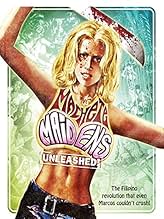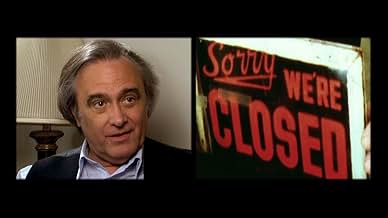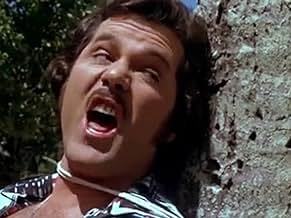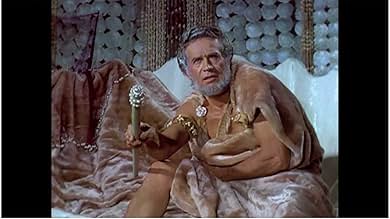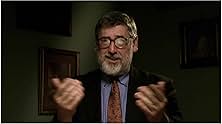IMDb रेटिंग
7.3/10
1.9 हज़ार
आपकी रेटिंग
अपनी भाषा में प्लॉट जोड़ेंA fast moving odyssey into the subterranean world of the rarely explored province of Filipino genre filmmaking.A fast moving odyssey into the subterranean world of the rarely explored province of Filipino genre filmmaking.A fast moving odyssey into the subterranean world of the rarely explored province of Filipino genre filmmaking.
Gerardo de Leon
- Self - Director
- (आर्काइव फ़ूटेज)
फ़ीचर्ड समीक्षाएं
I watched a couple of women-in-prison movies the other day. Both were made in the Philippines. This documentary goes behind the scenes to show why and how Roger Corman type films were made there. Cheap actors and lax safety rules made for an ideal situation for making low budget films.
Blood, breasts, and beasts were the staples of films like Mad Doctor of Blood Island, Beast of Blood, The Big Doll House, Women in Cages, Black mama, White Mama,The Big Bird Cage, and the classic Vampire Hookers.
We see stars like Pam Grier learning the craft in these cheap films. Part of a new wave of women as action heroes, which was new to moviegoers.
The documentary was invaluable in understanding the background of filmmaking.
Blood, breasts, and beasts were the staples of films like Mad Doctor of Blood Island, Beast of Blood, The Big Doll House, Women in Cages, Black mama, White Mama,The Big Bird Cage, and the classic Vampire Hookers.
We see stars like Pam Grier learning the craft in these cheap films. Part of a new wave of women as action heroes, which was new to moviegoers.
The documentary was invaluable in understanding the background of filmmaking.
This film is a documentary that celebrates trash cinema--specifically, the terribly cheesy American films made in the Philippines in the 60s and early 70s. Why did they go to this country? Simple--it was dirt cheap! So, cheap film makers like Roger Corman and Eddie Romero went there to create tons of terrible films--and the filmmakers knew it was going to be bad. There was no pretense--the films featured silly monsters, women in prison and the like. And, the films had tons of action, violence and boobies. Ultimately, however, there actually was a GOOD movie made there ("Apocalypse Now") and soon after this, the industry came to a halt due to violence and revolution...and ultimately the fall of the Marcos regime.
So is all this worth seeing and celebrating? Well, it depends on you. If you occasionally LIKE to see a terrible film (such as "Black Mama, White Mama"), then you'll like seeing the documentary (that's me!). You'll relive trashy but fun films or get ideas for movies to rent (though only about half the ones mentioned in the film are available from Netflix). But, if you are sane, you'll probably just wonder why anyone would want to remember these terrible films! Overall, however, the film is worth seeing if you are the type who can appreciate it--and I sure did. Just beware...the film is violent and infused with breasts!
So is all this worth seeing and celebrating? Well, it depends on you. If you occasionally LIKE to see a terrible film (such as "Black Mama, White Mama"), then you'll like seeing the documentary (that's me!). You'll relive trashy but fun films or get ideas for movies to rent (though only about half the ones mentioned in the film are available from Netflix). But, if you are sane, you'll probably just wonder why anyone would want to remember these terrible films! Overall, however, the film is worth seeing if you are the type who can appreciate it--and I sure did. Just beware...the film is violent and infused with breasts!
This is a very entertaining look at a specific time and place in the history of exploitation film-making. It documents the rather strange scenario where the Philippines became a hotbed of psychotronic cinema production between the 60's and early 80's. While I haven't seen more than two or three films that were made under these conditions, it didn't stop the film from being interesting and entertaining. In fact, like many similar documentaries Machete Maidens Unleashed! is most probably a lot more enjoyable than the films it features. Instead we get many, many clips from these crazy films, so it's difficult to get bored.
The films themselves range from the schlock horror of the 60's, via the women-in-prison flicks of the 70's to the martial arts action films of the 80's. It takes the form of the talking heads format where many of the participants tell us about their experiences working in the field. And perhaps unsurprisingly very different rules applied in the Philippines. There's a lot of humour in the presentation. No one is under any illusions about the seriousness of the movies, yet you will no doubt come away from this and have two or three new films you want to seek out. And I suppose with all that in mind, Machete Maidens Unleashed! has done its job.
The films themselves range from the schlock horror of the 60's, via the women-in-prison flicks of the 70's to the martial arts action films of the 80's. It takes the form of the talking heads format where many of the participants tell us about their experiences working in the field. And perhaps unsurprisingly very different rules applied in the Philippines. There's a lot of humour in the presentation. No one is under any illusions about the seriousness of the movies, yet you will no doubt come away from this and have two or three new films you want to seek out. And I suppose with all that in mind, Machete Maidens Unleashed! has done its job.
Directed by Mark Hartley, the man behind Electric Boogaloo: The Wild, Untold Story of Cannon Films, comes Machete Maidens Unleashed. It's a fast moving but pretty informative look at exploitation films in the late 60's, 70's and early 80's. It's main focus is to give explanation about the wild films that came out from the Philippines. Many of the B movie staples came from this era of film. It spans about 15 years where these films were all the rage at Drive-Ins and the rules didn't apply.
The film starts off with showing how production moved from the states to the Philippines after it was liberated by America. The country was very American friendly. Gerry de Leon and Eddie Romero were the first filmmakers to establish themselves and start making films. The first focus was on the Blood Island films of which there were a few. It's funny to hear the filmmakers talk about these films while clips are show. The films were goofy horror movies shot on shoestring budgets with thin plots and bad acting. What brought people to these films were the shocks promised from the trailers. There would be gore, obviously fake gore but monsters, science fiction and terror.
Roger Corman is introduced as producer as his time line crosses with that of Eddie Romero. Corman was a bigger name and he had lofty aspirations. Most of the 'hit' films being produced by him. The montage of what he was known for is hilarious. There's also a montage of all of the elements in a good Corman movie. Having not seen many of his film, it was interesting that he wanted to make the 'best' film with the money he had.
But the films out of this area Corman is known for where highlighted in a feature on women in prison film. These films were actually highly successful because of the way they portrayed women as the heroes. Even though they were meant to titillate and entertain, the films helped the up and coming feminist movement. There are interviews with many of the famous actress such as Pam Grier, Colleen Camp, Judith Brown, Leigh Christian & Gloria Hendry. They were put through the ringer. The interviews are the most fascinating here. There are first hand accounts of what the actresses had to go through. Some of the things they went through will be shocking but not against the times.
Sig Haig gives insight on what he had to go through in these films as well. Being that all these films were R-rated or not rated at all, it was refreshing to see the clips in all their uncensored glory. I would hate to watch a PG-13 version of this film. It wouldn't give the films their shock credit. There are ample amounts of nudity and bloody violence. The highlight of all the interviews is many of the moments with John Landis. He provides uncensored thoughts which are insightful and laugh out loud funny. I could have seen all the uncut footage from his interviews. I know there was more great commentary from the director.
In the middle of the 70's the blaxploitation films were all the rage. Two of the films that led the charge came out Phillippines. Cirio H. Santiago directed TNT Jackson, which many of the actors talked about. It was a film that mixed Kung Fu with full on action and had a black female lead. This section of the documentary is most about the late 70s mixing of martial arts in the B-movie era. The stunt work is highlighted as most of the actors did all their own stunts. And the extra were on board for doing anything. Many were injured and a few died. But it was the idea of being in a 'big' Hollywood film that tested people's limits. A small portion of the film is devoted to Francis Ford Coppola whose Apocalypse Now is infamous for it's filming in Philippines. It's only give a few minutes in the documentary but enough is shown that made me want to dive into Heart of Darkness.
The final stretch of the film speaks about Manila International Film Festival and the growing film market. Jaws and Star Wars are targeted as B-movies that were made on a A-level. With these films the decline of the Philippine cinema began. The final big success was the James Bond type spoof starting homegrown Weng Weng. It was the last hit of this era of B-movie cinema. This documentary was so insightful and entertaining. I wasn't bored for a minute. Given that it is unrated also help. So much footage was shown that I was intrigued to see some of these films as a whole. To my surprise, Netflix does carry many of these films. I can see a B-movie marathon in my future.
The film starts off with showing how production moved from the states to the Philippines after it was liberated by America. The country was very American friendly. Gerry de Leon and Eddie Romero were the first filmmakers to establish themselves and start making films. The first focus was on the Blood Island films of which there were a few. It's funny to hear the filmmakers talk about these films while clips are show. The films were goofy horror movies shot on shoestring budgets with thin plots and bad acting. What brought people to these films were the shocks promised from the trailers. There would be gore, obviously fake gore but monsters, science fiction and terror.
Roger Corman is introduced as producer as his time line crosses with that of Eddie Romero. Corman was a bigger name and he had lofty aspirations. Most of the 'hit' films being produced by him. The montage of what he was known for is hilarious. There's also a montage of all of the elements in a good Corman movie. Having not seen many of his film, it was interesting that he wanted to make the 'best' film with the money he had.
But the films out of this area Corman is known for where highlighted in a feature on women in prison film. These films were actually highly successful because of the way they portrayed women as the heroes. Even though they were meant to titillate and entertain, the films helped the up and coming feminist movement. There are interviews with many of the famous actress such as Pam Grier, Colleen Camp, Judith Brown, Leigh Christian & Gloria Hendry. They were put through the ringer. The interviews are the most fascinating here. There are first hand accounts of what the actresses had to go through. Some of the things they went through will be shocking but not against the times.
Sig Haig gives insight on what he had to go through in these films as well. Being that all these films were R-rated or not rated at all, it was refreshing to see the clips in all their uncensored glory. I would hate to watch a PG-13 version of this film. It wouldn't give the films their shock credit. There are ample amounts of nudity and bloody violence. The highlight of all the interviews is many of the moments with John Landis. He provides uncensored thoughts which are insightful and laugh out loud funny. I could have seen all the uncut footage from his interviews. I know there was more great commentary from the director.
In the middle of the 70's the blaxploitation films were all the rage. Two of the films that led the charge came out Phillippines. Cirio H. Santiago directed TNT Jackson, which many of the actors talked about. It was a film that mixed Kung Fu with full on action and had a black female lead. This section of the documentary is most about the late 70s mixing of martial arts in the B-movie era. The stunt work is highlighted as most of the actors did all their own stunts. And the extra were on board for doing anything. Many were injured and a few died. But it was the idea of being in a 'big' Hollywood film that tested people's limits. A small portion of the film is devoted to Francis Ford Coppola whose Apocalypse Now is infamous for it's filming in Philippines. It's only give a few minutes in the documentary but enough is shown that made me want to dive into Heart of Darkness.
The final stretch of the film speaks about Manila International Film Festival and the growing film market. Jaws and Star Wars are targeted as B-movies that were made on a A-level. With these films the decline of the Philippine cinema began. The final big success was the James Bond type spoof starting homegrown Weng Weng. It was the last hit of this era of B-movie cinema. This documentary was so insightful and entertaining. I wasn't bored for a minute. Given that it is unrated also help. So much footage was shown that I was intrigued to see some of these films as a whole. To my surprise, Netflix does carry many of these films. I can see a B-movie marathon in my future.
I don't usually give out such high ratings but Mark Hartley's new doco about the Filipino exploitation films of the 70's and 80's by way of Corman's New World Pictures is wonderful.
The interviews with former directors and stars are many and all entertaining. The clips and trailers shown are even better.
Any fan of B movies will love this.
I hope that this gets some sort of cinema release as Hartley and Co have clearly put much work and passion into this. His last doco NOT QUITE Hollywood was criminally ignored in this country.
After seeing the wretched INCEPTION (with a ridiculous budget of $150 Million) earlier in the evening, MACHETE MAIDENS UNLEASHED was a fine celebration of purely entertaining cinema made on low budgets.
More please Mr Hartley. How about Italian exploitation flicks of the 70's and 80's next? I wish cinema could be this fun again.
The interviews with former directors and stars are many and all entertaining. The clips and trailers shown are even better.
Any fan of B movies will love this.
I hope that this gets some sort of cinema release as Hartley and Co have clearly put much work and passion into this. His last doco NOT QUITE Hollywood was criminally ignored in this country.
After seeing the wretched INCEPTION (with a ridiculous budget of $150 Million) earlier in the evening, MACHETE MAIDENS UNLEASHED was a fine celebration of purely entertaining cinema made on low budgets.
More please Mr Hartley. How about Italian exploitation flicks of the 70's and 80's next? I wish cinema could be this fun again.
क्या आपको पता है
- ट्रिवियाAll the footage of Quentin Tarantino interviewing Cirio H. Santiago had to be cut from the final finished version of the film.
- कनेक्शनFeatured in Kain's Quest: The Arena (2017)
- साउंडट्रैकLet's Go Where the Action Is
Written and Performed by Tommy Boyce and Bobby Hart
टॉप पसंद
रेटिंग देने के लिए साइन-इन करें और वैयक्तिकृत सुझावों के लिए वॉचलिस्ट करें
- How long is Machete Maidens Unleashed!?Alexa द्वारा संचालित
विवरण
- रिलीज़ की तारीख़
- कंट्री ऑफ़ ओरिजिन
- आधिकारिक साइटें
- भाषा
- इस रूप में भी जाना जाता है
- Девки с мачете на свободе!
- फ़िल्माने की जगहें
- उत्पादन कंपनियां
- IMDbPro पर और कंपनी क्रेडिट देखें
- चलने की अवधि1 घंटा 24 मिनट
- रंग
- पक्ष अनुपात
- 1.78 : 1
इस पेज में योगदान दें
किसी बदलाव का सुझाव दें या अनुपलब्ध कॉन्टेंट जोड़ें



